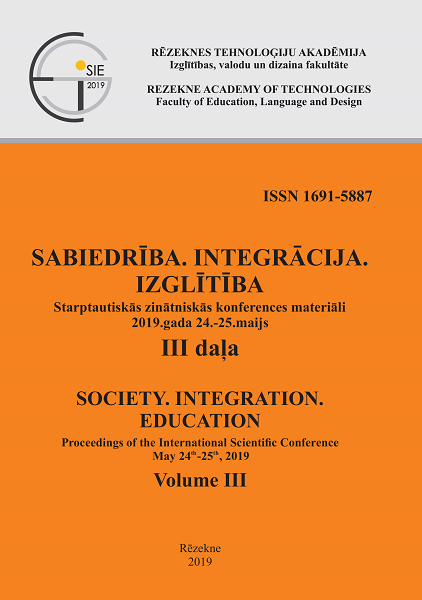THE PECULIARITIES OF TEACHING AN IDEOGRAPHIC LANGUAGE. TEACHING READING IN CHINESE
DOI:
https://doi.org/10.17770/sie2019vol3.3813Keywords:
character, hieroglyphic writing, ideographic language, grapheme competenceAbstract
Reading plays an important role in the educational process, as it is one of the central spheres in communication in a foreign language. However, reading Chinese has its own peculiarities, because the method of writing differs from the phonetic languages. The paper is devoted to the teaching reading in Chinese for beginners, using the peculiarities of an ideographic language. The outlining of these peculiarities and the development of exercises, with the consideration of these peculiarities are relevant, because most of the methodological developments are devoted to the teaching of reading phonetic languages.
The paper aims to determine the peculiarities of teaching reading in Chinese, which are caused by the ideographic character of the hieroglyphic writing.
The developed system of exercises for teaching reading in the Chinese language for beginners is provided. The exercises enable learners to get acquainted with the hieroglyphic writing, to build a grapheme competence and to learn how to write any character.
References
Guder A. ( 2007). The Chinese writing system as Third dimension of Foreign Language Learning. 汉字的认知与教学. P. 17—32.
Kupfer P. (2007). Eloquent but Blind — The Problem of Reading Proficiency in Chinese as a Foreign Language. 汉字的认知与教学. С1—17.
Overgaard S. (2007). An Analysis of Various Scholarly Approaches to the Acquisition of Chinese Characters by Students of Chinese as a Foreign Language. 汉字的认知与教学. P 463-488
Жукова К. Є. (2017) Поняття «Графемна компетенція» та її формування на початковому етапі вивчення китайської мови. Web of Scholar. №4 (13). Київ.
Жукова К. Є., Артюх О. І. (2016). Основи китайської ієрогліфіки: навчальний посібник для студентів, які вивчають китайську мову. Харків: ХНПУ.
Коул М. (1995). Культурные механизмы развития. Вопросы психологии. № 3. С. 5-20.
常用汉字偏旁部首表 Доступно: https://www.thn21.com/base/zi/41469.html
陈枫.( 2008). 对外汉语教学法. 北京: 中华书局.
姜丽萍(1998). 基础阶段留学生识记汉字的认知过程. 对外汉语教学探讨集. 页 319-328.
李大遂. (2003). 简明实用汉字学.北京:北京大学出版社.
李国英. ( 1996) 小篆中的形声字. 北京: 北京师范大学出版社.
李香平. (2006). 汉字教学中的文字学. 北京: 语言出版社.
王碧霞, 李宁, 种国胜, 徐叶菁(1997). 从留学生识记汉字的心理过程看汉字教学词汇. 文字研究与对外汉语教学. 页553-565.
王宁. (2002).汉字构形学讲座. 上海:上海教育.
郑振峰, 王军, 李






